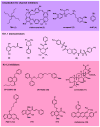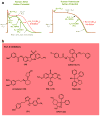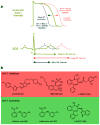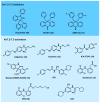Voltage-gated potassium channels as therapeutic targets
- PMID: 19949402
- PMCID: PMC2790170
- DOI: 10.1038/nrd2983
Voltage-gated potassium channels as therapeutic targets
Abstract
The human genome encodes 40 voltage-gated K(+) channels (K(V)), which are involved in diverse physiological processes ranging from repolarization of neuronal and cardiac action potentials, to regulating Ca(2+) signalling and cell volume, to driving cellular proliferation and migration. K(V) channels offer tremendous opportunities for the development of new drugs to treat cancer, autoimmune diseases and metabolic, neurological and cardiovascular disorders. This Review discusses pharmacological strategies for targeting K(V) channels with venom peptides, antibodies and small molecules, and highlights recent progress in the preclinical and clinical development of drugs targeting the K(V)1 subfamily, the K(V)7 subfamily (also known as KCNQ), K(V)10.1 (also known as EAG1 and KCNH1) and K(V)11.1 (also known as HERG and KCNH2) channels.
Figures







Similar articles
-
Pharmacological modulation of voltage-gated potassium channels as a therapeutic strategy.Expert Opin Ther Pat. 2010 Nov;20(11):1471-503. doi: 10.1517/13543776.2010.513384. Epub 2010 Aug 20. Expert Opin Ther Pat. 2010. PMID: 20726689 Review.
-
Voltage-Gated K+ Channel Modulation by Marine Toxins: Pharmacological Innovations and Therapeutic Opportunities.Mar Drugs. 2024 Jul 29;22(8):350. doi: 10.3390/md22080350. Mar Drugs. 2024. PMID: 39195466 Free PMC article. Review.
-
Venom-derived peptide inhibitors of voltage-gated potassium channels.Neuropharmacology. 2017 Dec;127:124-138. doi: 10.1016/j.neuropharm.2017.07.002. Epub 2017 Jul 5. Neuropharmacology. 2017. PMID: 28689025 Review.
-
A bifunctional sea anemone peptide with Kunitz type protease and potassium channel inhibiting properties.Biochem Pharmacol. 2011 Jul 1;82(1):81-90. doi: 10.1016/j.bcp.2011.03.023. Epub 2011 Apr 6. Biochem Pharmacol. 2011. PMID: 21477583
-
Pharmacological evidence for a key role of voltage-gated K+ channels in the function of rat aortic smooth muscle cells.Br J Pharmacol. 2004 Sep;143(2):303-17. doi: 10.1038/sj.bjp.0705957. Epub 2004 Aug 23. Br J Pharmacol. 2004. PMID: 15326038 Free PMC article.
Cited by
-
Fluorescent protein-scorpion toxin chimera is a convenient molecular tool for studies of potassium channels.Sci Rep. 2016 Sep 21;6:33314. doi: 10.1038/srep33314. Sci Rep. 2016. PMID: 27650866 Free PMC article.
-
Cardiac Delayed Rectifier Potassium Channels in Health and Disease.Card Electrophysiol Clin. 2016 Jun;8(2):307-22. doi: 10.1016/j.ccep.2016.01.004. Epub 2016 Apr 1. Card Electrophysiol Clin. 2016. PMID: 27261823 Free PMC article. Review.
-
Ion Channel Dysregulation in Head and Neck Cancers: Perspectives for Clinical Application.Rev Physiol Biochem Pharmacol. 2021;181:375-427. doi: 10.1007/112_2020_38. Rev Physiol Biochem Pharmacol. 2021. PMID: 32789787 Review.
-
Antigenic Stimulation of Kv1.3-Deficient Th Cells Gives Rise to a Population of Foxp3-Independent T Cells with Suppressive Properties.J Immunol. 2015 Aug 15;195(4):1399-1407. doi: 10.4049/jimmunol.1403024. Epub 2015 Jul 6. J Immunol. 2015. PMID: 26150529 Free PMC article.
-
Ion channel expression in the developing enteric nervous system.PLoS One. 2015 Mar 23;10(3):e0123436. doi: 10.1371/journal.pone.0123436. eCollection 2015. PLoS One. 2015. PMID: 25798587 Free PMC article.
References
-
- Papazian DM, Schwarz TL, Tempel BL, Jan YN, Jan LY. Cloning of genomic and complementary DNA from Shaker, a putative potassium channel gene from Drosophila. Science. 1987;237:749–753. Study describing the cloning of the first KVchannel. - PubMed
-
- Long SB, Campbell EB, Mackinnon R. Crystal structure of a mammalian voltage-dependent Shaker family K+channel. Science. 2005;309:897–903. First description of the crystal structure of a voltage-gated mammalian K+ channel with its associated β-subunit. - PubMed
-
- Long SB, Campbell EB, Mackinnon R. Voltage sensor of Kv1.2: structural basis of electromechanical coupling. Science. 2005;309:903–908. Companion paper to Ref. 3 describing the structural basis of voltage-sensor and pore-domain coupling. - PubMed
-
- Swartz KJ. Towards a structural view of gating in potassium channels. Nat Rev Neurosci. 2004;5:905–916. - PubMed
Publication types
MeSH terms
Substances
Grants and funding
LinkOut - more resources
Full Text Sources
Other Literature Sources
Molecular Biology Databases
Miscellaneous

